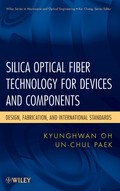Silica Optical Fiber Technology for Device and Components
Design, Fabrication, and International Standards
Wiley Series in Microwave and Optical Engineering (Band Nr. 1)

1. Auflage März 2012
472 Seiten, Hardcover
Fachbuch
Kurzbeschreibung
As the emphasis in optical fiber research expands from transmission media to functional fiber devices, various types of specialty optical fibers are being actively developed. Especially in dense wavelength multiplexing (DWDM) systems, novel functions such as fiber filters, fiber MUX/DEMUX, fiber amplifiers, among others, are constantly needed and supplied by specialty fibers. Until recently, optical fibers were treated as passive transmission media with very little attention given to these novel fiber technologies. Features of the book include:
* Includes review of specialty fiber fabrication technologies.
* Discussion of dispersion managed fiber technology for high capacity WDM applications.
* Covers optical fiber technologies for broadband fiber amplifiers, optical fiber technologies for fiber filleters based on periodic coupling, optical fiber technologies for fiber branching devices, and optical fiber technologies for fiber terminations.
From basic physics to new products, Silica Optical Fiber Technology for Device and Components examines all aspects of specialty optical fibers. Moreover, the inclusion of the latest international standards governing optical fibers enables you to move from research to fabrication to commercialization.
* Reviews all the latest specialty optical fiber technologies, including those developed for high capacity WDM applications; broadband fiber amplifiers; fiber filleters based on periodic coupling; fiber branching devices; and fiber terminations
* Discusses key differences among single mode fibers, multimode fibers for high speed Ethernet LAN, and dispersion compensating fibers for long-haul applications
* Compares the most recently developed conventional optical fibers with the latest photonic crystal fibers still in development
A self-contained, menu-driven software program is included for optical fiber design, simulating waveguide structures for most of the fibers discussed in the book.
Acknowledgment xiii
1 Introduction 1
1.1 Brief Historical Review of Silica Optical Fibers 1
1.2 International Standards for Silica Optical Fibers 8
1.3 Classifications of Silica Optical Fibers 12
References 16
2 Review on Single-Mode Fiber Design and International Standards 18
2.1 Optical Modes in Cylindrical Waveguides 18
2.2 Material Dispersion in Optical Fibers 37
2.3 Optical Attributes for Single-Mode Fiber Characterization and Classification 48
2.4 International Standards for Single-Mode Fibers 64
References 79
3 Preform Fabrication and Optical Fiber Drawing Process 83
3.1 Preform Fabrication Based on Chemical Vapor Deposition Process 83
3.2 Postprocesses for Geometrical Modification of Preform 101
3.3 Optical Fiber Drawing 104
References 126
4 Dispersion-Managed Single-Mode Fibers for Wavelength Division Multiplexing 131
4.1 Wavelength Allocations in Single-Mode Fibers for WDM Applications 131
4.2 Optimization of Waveguide Parameters for Dispersion Control 137
4.3 Refractive Index Profile Analysis for Dispersion-Shifted Fibers 150
4.4 Dispersion-Compensating Fibers Using the Fundamental Mode 157
4.5 Dispersion Compensation Using High-Order Modes 168
References 181
5 Multimode Fibers for Large-Bandwidth Applications 185
5.1 History and Recent Application Trends of Multimode Optical Fibers 185
5.2 Principle of Multimode Optical Fiber Design 190
5.3 Impacts of Nonideal a-Refractive Index Profile on Transmission Bandwidth 197
5.4 Main Attributes of GI-MMFs-Bandwidth and Differential Modal Delay 203
5.5 Multimode Optical Fiber Standards 213
References 221
6 Optical Nonlinearity Control in Optical Fibers 224
6.1 Historical Review of Optical Nonlinearity in Optical Fibers 224
6.2 Origin of Optical Nonlinearities in Optical Fibers 226
6.3 Specifications of Nonlinear Optical Processes in Optical Fibers 231
6.4 Comparison of Raman and Brillouin Scattering in Single-Mode Optical Fibers 234
6.5 Control of Raman Scattering in Silica Optical Fibers 236
6.6 Brief Review on Raman Amplifiers and Lasers 245
6.7 Control of Brillouin Scattering in Silica Optical Fibers 253
6.8 Review on Fiber Brillouin Sensors and Recent Novel Applications 267
References 273
7 Birefringence Control in Optical Fibers 280
7.1 Physical Parameters for the Polarization Characterization in Optical Fibers 280
7.2 Representation of the State of Polarization in Optical Fiber Using Poincare Sphere 286
7.3 Classifications of Linear Polarization Maintaining Fibers 290
7.4 Fabrication Methods for High Birefringence Fibers 294
7.5 Control of Birefringence by Waveguide Design in Birefringent Fibers 296
7.6 Single-Polarization Single-Mode Fibers 304
7.7 Low Linear Birefringence Fibers 310
References 316
8 Optical Fibers Based on Air-Silica Guiding Structure 321
8.1 Review of Air-Silica Guidance in Optical Fibers 321
8.2 Fabrication Technique--Stack and Draw Method 322
8.3 Effective Index Guiding Air-Silica Optical Fibers 324
8.4 Large Mode Area and Bending Loss Based on Effective Index Guiding Air-Silica Holey Fibers 331
8.5 Dispersion Control in Effective Index Guiding Air-Silica Holey Fibers 335
8.6 Optical Loss in Effective Index Guiding Air-Silica Holey Fibers 342
8.7 Kerr Nonlinearity in Effective Index Guiding Air-Silica Holey Fibers 347
8.8 Birefringence Control in Effective Index Guiding Air-Silica Holey Fibers 351
8.9 Hollow Optical Fiber and its Applications 355
References 368
9 Fiber Mode Analysis Using OFACAD 378
9.1 Theoretical Review on Cascaded Boundary Matrix Method 378
9.2 Algorithm for CBM to Find Optical Properties of Guided Modes 384
9.3 Mode Analysis Example Using OFACAD 386
References 399
Appendix A: OFACAD Installation/Operation Manual 401
Appendix B: Operation Manual of OFACAD 415
Index 447
UN-CHUL PAEK, PhD, was Professor at the Gwangju Institute of Science and Technology. Dr. Paek was a Fellow at Bell Labs, an OSA Fellow, and a Member of National Academy of Engineering, United States.


